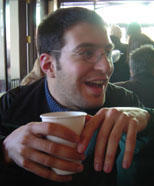Biggest Finding of the Year
Yes everyone has his/her lists ... but it's oh-so-fun. So here goes, the biggest finding of the year. (This might be a little RNA-centric!)
Central Dogma of Biology overturned! (???)
Have a near-lethal mutation in your DNA? Researchers from Robert Pruitt's lab at Purdue suggest that in Arabidopsis thaliana (the model organism for studying plant genetics), mutants can attempt to alter upto 10% of the genome so that the next generation may rid itself of the deleterious gene. The reversion process is stimulated by stress - it's as if the organism knows that something is wrong, and attempts to correct the error so that the next generation is free of potentially bad (or deleterious) mutant gene. Since the organism does not know what is the bad gene, it willy-nilly reverts upto 10% of the genome. Consequentially 10% of the offspring have fixed the offending gene. The altered genes often contain sequences found in the grandparent's DNA that were not inherited in the parent's genome. So where did the extra genetic information come from? These researchers suggest that the parents store extra-genomic information from grandparents. Since the researchers could not find any of this information in the parental DNA, it may be stored in RNA versions of the genes that are retained between generations. Of course for the theory to be proven, the team from Purdue need to identify this inherited RNA.
So it use to be thought that information in biology flowed in one direction: DNA => RNA => protein (i.e. the Central Dogma of Biology). But in this case RNA is the potential source of the backup genes. In the case of stress, backup-RNA => DNA.
As with all great findings, there are controversies. Abed Chaudhury has claimed an alternative "fix" for the poor arabadopsis mutant, where bad genes may be turned off using RNAi. How are 10% of the genes reverted? ... Dr Chaudhury postulated that sick individuals may fix genes by soaking up DNA from the environment ... this alternative theory needs to be tested and would be as remarkable as the RNA-backup theory.
And a second researcher, Animesh Ray, postulated that mersitem cells may store parental-DNA- fragments. These DNA fragments may be used to revert genes in the gametes of sick individuals. Again, someone should be asking "show me the DNA".
So yes my finding of the year is a big question mark, however this line of investigation has shown that our current understanding of inheritance is flawed ... somehow organisms can fix mutant genes. Hopefully 2006 will bring us closer to how this really works.
Lolle S.J. et al., Genome-Wide Non-Mendelian Inheritance of Extra-Genomic Information in Arabidopsis Nature (2005) 434: 505
Chaudhury A., Plant genetics: Hothead healer and extragenomic information Nature (2005) 437:E1
Ray A., Plant genetics: RNA cache or genome trash? Nature (2005) 437:E1-E2
Central Dogma of Biology overturned! (???)
Have a near-lethal mutation in your DNA? Researchers from Robert Pruitt's lab at Purdue suggest that in Arabidopsis thaliana (the model organism for studying plant genetics), mutants can attempt to alter upto 10% of the genome so that the next generation may rid itself of the deleterious gene. The reversion process is stimulated by stress - it's as if the organism knows that something is wrong, and attempts to correct the error so that the next generation is free of potentially bad (or deleterious) mutant gene. Since the organism does not know what is the bad gene, it willy-nilly reverts upto 10% of the genome. Consequentially 10% of the offspring have fixed the offending gene. The altered genes often contain sequences found in the grandparent's DNA that were not inherited in the parent's genome. So where did the extra genetic information come from? These researchers suggest that the parents store extra-genomic information from grandparents. Since the researchers could not find any of this information in the parental DNA, it may be stored in RNA versions of the genes that are retained between generations. Of course for the theory to be proven, the team from Purdue need to identify this inherited RNA.
So it use to be thought that information in biology flowed in one direction: DNA => RNA => protein (i.e. the Central Dogma of Biology). But in this case RNA is the potential source of the backup genes. In the case of stress, backup-RNA => DNA.
As with all great findings, there are controversies. Abed Chaudhury has claimed an alternative "fix" for the poor arabadopsis mutant, where bad genes may be turned off using RNAi. How are 10% of the genes reverted? ... Dr Chaudhury postulated that sick individuals may fix genes by soaking up DNA from the environment ... this alternative theory needs to be tested and would be as remarkable as the RNA-backup theory.
And a second researcher, Animesh Ray, postulated that mersitem cells may store parental-DNA- fragments. These DNA fragments may be used to revert genes in the gametes of sick individuals. Again, someone should be asking "show me the DNA".
So yes my finding of the year is a big question mark, however this line of investigation has shown that our current understanding of inheritance is flawed ... somehow organisms can fix mutant genes. Hopefully 2006 will bring us closer to how this really works.
Lolle S.J. et al., Genome-Wide Non-Mendelian Inheritance of Extra-Genomic Information in Arabidopsis Nature (2005) 434: 505
Chaudhury A., Plant genetics: Hothead healer and extragenomic information Nature (2005) 437:E1
Ray A., Plant genetics: RNA cache or genome trash? Nature (2005) 437:E1-E2


<< Home